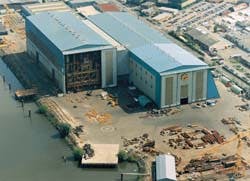Fabricators soldier on despite modest pickings in Dutch sector
(Left) The Grootint fabrication yard at Zwijndrecht where the M5 and M6 Nkossa topsides modules were built. (Right) Load-out of the modules for the Nkossa floating production barge.
A downturn in activity on the Dutch continental shelf is making its mark on the Dutch fabrication industry. Following the closure of the De Schelde Offshore yard last year, only Heerema Fabrication Group (HFG), HSM, Mercon and Volker Stevin are left as major players. And the greater part of their workload is coming from abroad.
Denmark's Maersk Olie og Gas is HFG's most important client today. The topsides for the Harald West A platform were completed at the Grootint yard in Zwijndrecht earlier this summer, as well as the Harald jacket, fabricated at Heerema Havenbedrijf in Vlissingen. These units contain some 4,500 tons of steel each.
A third major project for Maersk is the construction of the 8,000 ton Dan FF module and bridge which are due to be delivered next July. These are EPC contracts except for the jacket, where only construction was requested.
HFG's Grootint yard delivered two modules for the Elf Congo's Nkossa oil and gas development late last year. The M5 oil treatment and M6 gas/LPG treatment modules, each weighing around 4,500t, were transported by barge to the Mediterranean for assembly and further transport to West Africa.
A few Dutch sector awards have been issued lately. Elf Petroland gave Heerema Havenbedrijf the EPIC contract for a 600t compression module for its K6-C platform. Production from K6-C, which takes in gas from a number of satellites in the block, has begun to decline having reached a peak close to 5mcm/d in 1994. HFG also received a letter of intent for construction of the K14-FE wellhead platform jacket from operator NAM in June.
This summer, it emerged that HFG is considering closing the Penn & Bauduin yard in Dordrecht: this facility has, however, performed no offshore sector work for several years.
Solitaire
HSM delivered the 110-metre long stinger for Allseas' new large diameter pipelay vessel Solitaire in June. The fabrication was performed at HSM's Schiedam yard and delivered to Swan Hunter in Newcastle for installation on the vessel's stern. The stinger will enable Allseas to use the S-lay method for pipelaying in deep water.
Earlier this year HSM was awarded the contract for the construction of the L9-FF-1 jacket and piles which will consume a total of 700 tonnes of steel. A CALM/PLEM mooring system for an FPSO built by Bluewater Engineering will also be delivered by HSM in October.
As a subcontractor to the Volker Stevin Offshore/Hollandia joint venture, HSM received an order for the construction of three decks for Clyde's P2/P6 jack-up production platforms. The first of these three platforms will be assembled at the RDM yard in Rotterdam in September. The other two will follow during the last quarter of 1996 and the first quarter of 1997.
Each of the platforms will contain some 2,300t of steel. Work is also being performed at the Hollandia steel construction plant in Krimpen a/d IJssel and by CKT Containertechniek in Rotterdam, which fabricates accommodation and other modules. The complete power packages for all three units are being delivered on a turnkey basis by DBR of Hardinxveld.
This March, Mercon Steel Structures was awarded the EPIC contract for Elf Petroland's K5-EN/C platform, the fourth and probably last installation to be placed in the K5 block. The deck will contain around 600t of steel, the jacket 560t and the piles 300t. Delivery is scheduled for summer 1997.
Amongst the more specialised Dutch construction companies, steel fabricator Sif Holland is building the piles for the UK's Britannia and Armada projects. Verolme Botlek, better known for rig upgrades, also bid for Amerada Hess' Glas Dowr tanker-FPSO conversion, but lost out. However it is planning a renewed push in this market.
HSM built the stinger for the new Allseas pipelayer Solitaire, currently at Swan Hunter's yard in Newcastle, UK for refurbishment.
Demolition
On the reverse engineering front, an alliance of three Dutch firms opened a demolition yard for offshore platforms in Rotterdam harbour this June. They bought the three Esmond/Gordon platforms from BHP which were removed from the field by Heeremac and then delivered for scrapping in Rotterdam.
Partners in the alliance are Curef Metal Processing, crane barge owner Harpo International and waste processing plant Afvalverwerking Rijnmond (AVR). A temporary environmental licence was issued by the local authorities for the work on the three platforms.
A spokesman for BHP declared that "Esmond/Gordon produced clean, dry gas and therefore the structures are seen as a benign environment, with no problems of pollutants. The risers were flushed with seawater and cut off at the seabed." On delivery onshore for disposal, the risers were still attached to the structures.
The offshore demolition yard is the first in The Netherlands dedicated to this type of work. Another offshore abandonment alliance, ROS-Holland, was formed a few weeks earlier. This group is looking for a suitable site for a break-up yard in the IJmuiden or Den Helder area.
Copyright 1996 Offshore. All Rights Reserved.

